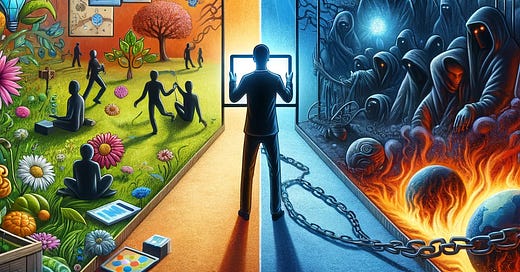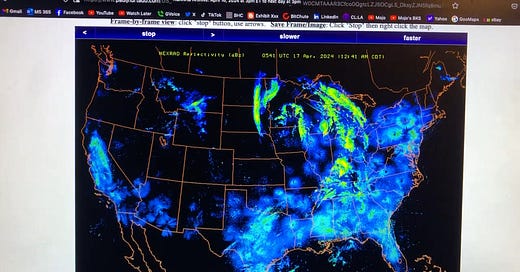
Is the Next American Revolution Going to Take Place in Our Minds?
If our brains are the new battlefield, isn't it time to launch a counterattack?
Imagine living in a world where a single event rewired the brains of an entire generation. For instance, the Great Depression did more than cripple the economy—it plunged the American psyche into a perpetual 'fight-or-flight' mode. This wasn't just a fleeting moment in history; it was a seismic shift that echoes in our collective consciousness, shaping how we perceive and react to the world around us. Let's dive into how this pivotal era set the stage for our current state and uncover transformative steps to navigate our inherited legacy of fear.
HISTORICAL PRETEXT FOR OUR ADDICTION TO FEAR
Wrapping up 2023 and reflecting upon the impact of fear and conditioning on our personal and collective consciousness, there’s plenty of historical context on how we got here, tracing back to events like the 300-year-long European witch hunts and the Great Depression, leaving a lasting imprint on our societal DNA, intergenerational trauma, and why many Americans have such an overriding addiction to fear.
How do we break free from these chains? Perhaps the true revolution lies within our brains through a conscious and surprisingly small shift that enables us to recognize and transform these deeply ingrained patterns.
I mean, if there is a plot against the American mind and a “battle for our brains,” shouldn’t we be doing everything we can to reclaim it?
So, perhaps a path to true freedom lies in understanding the concept of fear as an addiction — permeating and enslaving us in nearly every aspect of our lives — and seeking a proactive approach to combat this. The idea is to focus on small, seemingly insignificant actions that collectively can steer society in a new direction. This includes personal practices like appreciation and gratitude to break free from the cycle of fear and anxiety.
THE RISE OF ‘DANGEROUS OTHERNESS” IN A COVID WORLD & THE 5 WAYS FEAR KEEPS US ENSLAVED
The current state of inhumanity and “societal detachment” have been exacerbated by events like the COVID-19 pandemic —which utilized social engineering techniques such as Fear Appeal and Biderman’s Chart of Coercion — have hyper-driven the reduction in American’s compassion, empathy, and inquiry these days as I had hit upon in an earlier substack, here, here, and here.
The constant exposure to 24/7 news and social media significantly contributes to a rising sense of fear in several ways:
Information Overload: Continuous news and social media streams bombard individuals with information, much of which may be negative or alarming. This constant flow can be overwhelming, keeping people in a heightened state of alertness and anxiety.
Negativity Bias: News outlets often focus on negative events, such as crimes, disasters, and conflicts, because these stories attract more attention. This focus can skew a person's perception of reality, making the world seem more dangerous than it actually is.
Echo Chambers and Confirmation Bias: Social media algorithms show users content that aligns with their beliefs and opinions, creating echo chambers. This can reinforce fears and anxieties, as individuals are repeatedly exposed to similar types of content that confirm their worries.
Fear of Missing Out (FOMO): Social media can also induce anxiety through the fear of missing out on events, experiences, or news. This can lead to compulsive checking of news feeds and social media platforms, perpetuating a cycle of fear and anxiety.
Dramatization and Sensationalism: News stories and social media posts are often dramatized or sensationalized to capture attention. This can amplify fears and lead to misperceptions about the likelihood or severity of certain threats.
Collective Anxiety: Social media can create a sense of collective anxiety, where the fears and worries of others are amplified and shared, contributing to a heightened sense of crisis or danger.
No Downtime from Stress: The always-on nature of digital media means that people have little respite from stress-inducing news and social interactions, which can exacerbate anxiety and fear.
ENDING THE PRIMAL EMOTION CONTROLLING AMERICANS
Fear (that ultimately transpires into anxiety), as a primal emotion, has profound effects on the brain, triggering a cascade of physiological responses that prepare the body for perceived threats. When an individual experiences fear, the amygdala, a small, almond-shaped structure in the brain, is activated. This activation signals other brain regions, including the hypothalamus, which initiates the body's fight-or-flight response. Concurrently, the amygdala communicates with the brainstem, increasing heart rate, blood pressure, and breathing rate. This response is designed to prepare the body for rapid action, either to confront the danger (fight) or to flee from it (flight). During this state, stress hormones such as cortisol and adrenaline are released, further priming the body for emergency action.
However, this heightened state of alert can have negative consequences when sustained over time. The brain's prefrontal cortex, responsible for higher-order thinking, decision-making, and rational thought, becomes less effective when the amygdala is overactive. This can lead to impaired judgment and decision-making in fearful situations. Prolonged exposure to stress and fear can also lead to chronic health issues such as anxiety disorders, depression, and heart problems. The persistent release of stress hormones can weaken the immune system, disrupt sleep patterns, and even affect memory and cognitive function. These physical effects of fear highlight the importance of managing fear and stress in a healthy manner to maintain both mental and physical well-being.
SOCIAL MEDIA & MSM DRIVING THE FEAR
We all know fear sells, but everything, including fears, seems to be on steroids these days, and we see the collective impacts of this. And we also know the hand social media and mainstream news (MSM) have played in this.
Social media platforms like Facebook/Meta have designed their algorithms to capitalize on the brain's response to fear and reward. They use engaging and often sensational content to trigger emotional reactions and dopamine release, thereby encouraging habitual use and addiction.
So, how do we become more strategic in utilizing social media and information in such a way that it does not paralyze and then addict us?
First, let’s have a cursory exploration of how we got here.
Witch hunts. They are good for the economy.
Bad for the DNA.
ECONOMIC ENGINE OF WITCH HUNTS
The European witch hunts, spanning roughly from the late 15th century to the mid-18th century, were a period marked by widespread hysteria, superstition, and the persecution of individuals accused of witchcraft. These hunts were particularly intense in Central Europe, with significant occurrences in Germany, France, and the British Isles. The phenomenon was fueled by a mix of religious fervor, social and economic upheaval, and local politics. The publication of the "Malleus Maleficarum" in 1487, a treatise endorsing the persecution of witches, played a significant role in legitimizing and spreading the witch-hunt fervor. Accusations of witchcraft were often directed at marginalized individuals, particularly women, who were blamed for a variety of misfortunes, including poor harvests, diseases, and unexplained deaths.
Economically, the witch hunts had a notable impact on local economies in Europe. The process of trying and executing accused witches often involved legal fees, costs for imprisonment and transportation, and remuneration for witch-hunters and inquisitors. This created a perverse economic incentive, as local authorities, judges, and church officials could profit from the proceedings. In some regions, the seizure of the accused's property also became lucrative, further motivating baseless accusations. Additionally, the fear and suspicion fostered by the witch hunts disrupted community cohesion and could have long-term economic repercussions. These hunts, therefore, reflected the social and religious anxieties of the time and were intertwined with economic interests, often at the cost of justice and human lives.
Sound familiar?
…. (the European witch hunts) divided our communities, taught us to play small in order to survive and broke our trust in the people closest to us.
The scars we still carry show up in many ways - fears of being seen or heard, experiences of betrayal, mistrust of other women, feelings of disconnection to nature, irrational fears, and struggles to feel at home in ourselves.
'25 generations on we are left feeling powerless, isolated, stuck, divided, unsafe and unsupported. It is affecting our health and well-being in so many ways and we’re tired of it.
'The Silver Spoons Collective is on a mission to shine a light on the shadows of the past so we may heal, grow and create new ways of being, rooted in healthy connection to ourselves, each other and the Earth.'
Cali suggested the 'inherited wounds' are now deep in 'our own psyche and keep us stuck, small and separate.'
'What were survival strategies for our ancestors of 25 generations ago, are now entrenched beliefs and behaviours that wreak havoc with our own health and well-being and can be extremely self-destructive,' she said.
HOW EPIGENETICS HAS TURNED INTO GENERATIONS OF FEAR
Epigenetics, the study of how your behaviors and environment can cause changes that affect the way your genes work, plays a crucial role in how fear is processed and potentially transmitted across generations. Unlike genetic changes, epigenetic modifications do not alter the DNA sequence but can change how the body reads a DNA sequence. When an individual experiences fear or trauma, it can lead to epigenetic changes in the DNA, particularly in genes associated with the stress response. These changes can affect the functioning of the amygdala, the brain's fear center, making an individual more susceptible to fear and anxiety. Some studies suggest that these epigenetic changes can be passed down to subsequent generations, potentially predisposing them to similar fear responses. This transgenerational transmission of fear responses implies that experiences of ancestors, like enduring hardships or trauma, could influence the stress responses of descendants through epigenetic mechanisms, embedding a legacy of fear at a molecular level.
BREAKING THE CYCLE OF FEAR’S ENSLAVEMENT WITH APPRECIATION
Looking towards 2024, I envision a year of significant change, a pivot from fear to conscious action — predominantly due to necessity.
I propose practical and simple steps for individuals to reclaim their humanity and agency, such as gardening, local community engagement, and art.
Yes, the steps are that simple. Little undertakings like these bring in the same frequency — like attracts like.
Shifting into a state of appreciation profoundly affects the brain, breaking the cycle of negative or fearful thoughts and promoting mental well-being. Engaging in appreciation or gratitude stimulates the brain regions associated with positive emotion and reward, particularly the prefrontal cortex, which is responsible for emotional regulation and perspective-taking. This shift triggers feel-good neurotransmitters like dopamine and serotonin, enhancing mood and fostering a sense of calm. Appreciation also reduces the activity in the amygdala, the brain's fear center, diminishing feelings of anxiety and fear. This neural change helps disrupt the cycle of negative thoughts, allowing for a more balanced and positive mental state. Regularly practicing gratitude strengthens these neural pathways, making it easier to shift into a state of appreciation over time. This helps in immediate stress reduction and contributes to long-term emotional resilience, enhancing overall life satisfaction and mental health.
ONE CAN NOT BE IN APPRECIATION/GRATITUDE & FEAR SIMULTANEOUSLY
"One cannot simultaneously be in a state of appreciation/gratitude and fear. This small, conscious tactic severs the tentacles of fear from our minds, allowing us an opportunity to reconfigure our own thoughts and DNA.
Once that little gear in the mind shifts, it shifts everything else accordingly. The more you do this, the easier it becomes.
You are simply doing what you have been doing unconsciously your whole life but now taking control of it.
"By consistently practicing this approach, you'll embed a healthy pattern in your mind. The key is to shift your focus: move away from constantly seeking out fear and instead concentrate on the present moment. Begin taking small, deliberate steps towards crafting the world you envision.
Shifting from fear to gratitude is a journey marked by incremental actions that might initially seem inconsequential.
Our power lies in repetition. Each small step, repeated over time, builds a path toward significant change within the brain, and then everything else in the physical world follows suit. Remember, the most profound transformations often start with the smallest actions, consistently applied.
Please note that I have been using a ChatGPT plug-in to create images in this article that illustrate my writing. I would love your feedback on this. Does it add to the article, take away, or downright annoy? Comment below, please.
If you find these interviews and articles informative, please become a paid subscriber for under 17¢ a day. I don’t believe in paywalls, but this is how I make a living, so any support is appreciated. Either way…. it’s available to you…

























I had not considered that the 1930s Depression had embedded trauma in our DNA, but it makes perfect sense. With the strength of that event and the others you note, the burning times for example, being part of us for so long, it almost seems that shifting one or two small things is not going to make much difference. But I am sure you are right about gratitude and appreciation, and the power of that.
As an academic editor who has been replaced by AI (grad students have stopped asking for my help in the past 7-8 months, quite precipitously), I have a quite negative view of using AI for anything beyond repetitive mental tasks. Human creativity, be it visual art or writing one's own ideas into a well-crafted argument, should, in my view, NEVER be aided, and certainly not replaced, by AI. For the artwork, Chat GPT to make illustrations means that human artists do not get to do this work and get paid for it, and to me adds a taint of artificiality to the art.
When it comes to writing, whether it's a dissertation, a cover letter for a job application or a business marketing plan, AI is a crutch that inevitably will lead to people not being able to communicate their ideas themselves--but also not even being able to think clearly. Using AI to write, and to do art, is straight-up transhumanism, without the need for virtual reality goggles or a brain chip. It's human beings offloading some of their own unique creativity onto a robot and becoming dependent on that crutch more and more every day.
AI may have its place as an assistant to human work. But it's a very slippery slope. I appreciate that you let us know you'd used it, and asked for feedback. It seems to me that many people are unthinkingly accepting AI as a personal helper to do their own work, and are not realizing that they are stepping onto that slope that will slowly erode their own ability to think.
Our consciousness, I believe, is not subject to the vicititudes of life on earth. Once we realize this, we are truly free. This does not mean our bodies or brains are not vulnerable. I hope in the coming year of 2024, we will be exploring all ways to protect our immune system and thus our brains. We need to work together, in a community of healers. There is power in numbers, personal power, and collective power. Let's make 2024 the year of Awakening to our true potential and the healing of our planet.